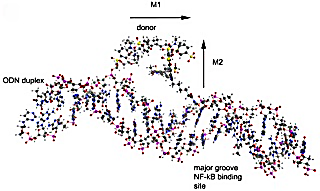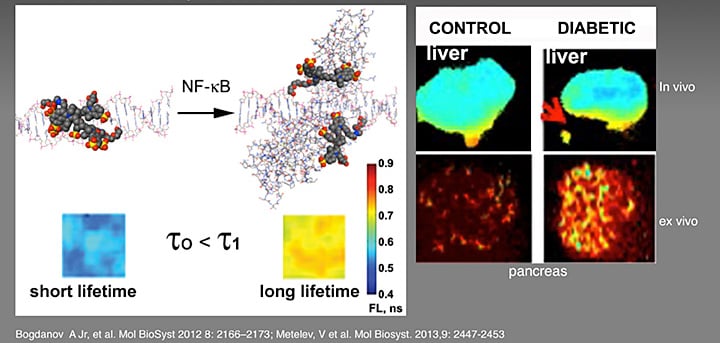Transcription Factor Imaging Probes
We developed a family of novel oligonucleotide molecular reporters based on oligonucleotide duplexes that carry covalently linked fluorescent dyes. These dyes undergo a change of their fluorescent properties when transcription factor/regulator proteins recognize and binding to the nucleotide sequence motif encoded in the duplex probe. Reporters of gene transcription could potentially be used in phenotyping and staging of disease, as well as for evaluating new therapies.

A – a model generated in molecular operational environment (MOE) showing the formation of a non-emitting dye pair formed by the ODN-linked Cy5.5 and 800CW donor/acceptor. The dyes interact within the major groove resulting in perpendicular orientation of transitional dipoles (M1,M2) of donor and acceptor. MMFF force field with an interactive conformational search/energy minimization algorithm after adding molecular water layer/NaCl around the probe.
Molecular Fluorescence Lifetime Imaging Sesnor of Pro-inflammatory Signaling in Diabetes
Goal: Non-invasively detect early inflammatory changes in diabetic pancreas

Left panel: The non-emitting dye pair complex responds to NF-kappaB binding by transitioning to a state with a longer fluorescence lifetime. Right panel: -Fluorescence lifetime imaging maps of mice and isolated organs in situ.
Bogdanov A. Jr. et al. Mol BioSyst 2012 8:2166-2173;
Metelev, V el.al. Mol Biosyst 2013 9: 2447-2453
The future goals of our research:
- Optimization and characterization of far-red fluorophore labeled ODMRs.
- Development of a transcription factor reporter intracellular delivery system.
- Investigation of transcription-factor reporting properties in cell culture and in vivo.